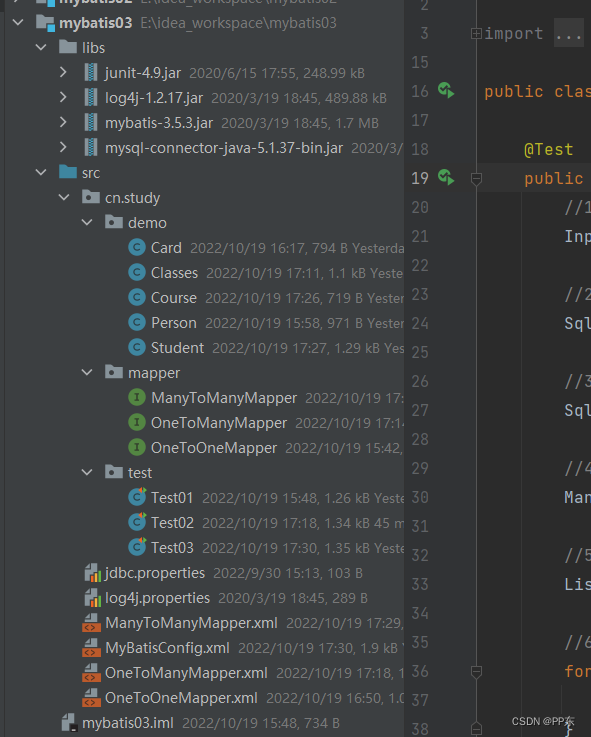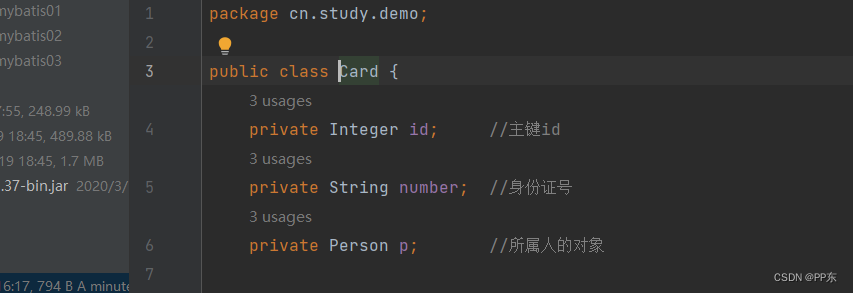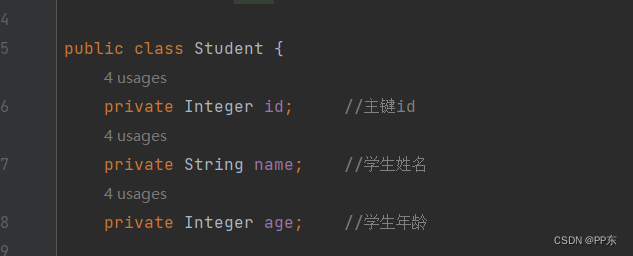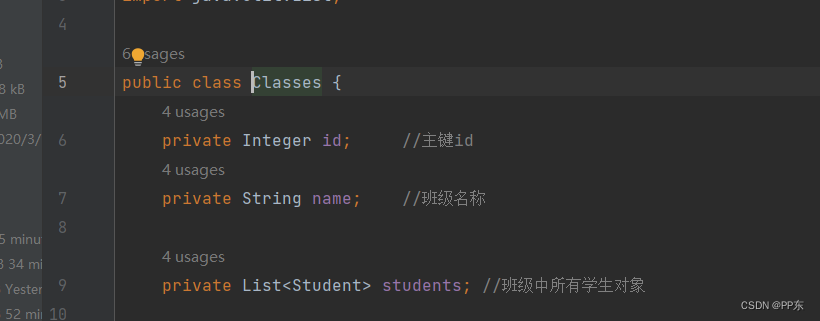这里写目录标题
一、动态sql语句
1.1 动态sql概述
在开发中会涉及到复杂逻辑时,SQL时动态变化的,所以要用到动态SQL。
1.2 的使用
1.2.1 用之前的查询测试
因为入参会涉及到有的为空有的非空。比如有的是用id查询,有的是用name查询,有的是同时用id和name查询。
这里我先写了一个查询:
<select id="queryBy" resultType="student">
SELECT * FROM student where sid=#{sid} and name=#{name}
</select>
```
然后按照之前说的写service,在写测试:
@Test
public void queryBy() {
Student stu = new Student();
stu.setSid(4);
List students = service.queryBy(stu);
System.out.println(students.size());
for (Student stu1 : students) {
System.out.println(stu1);
}
}
```
最后的查询结果却与我们预想的不一样:

出现这种现象的原因也很好理解,以为name没有入参,但是sql最后执行的时候默认为null带到sql中,导致数据查询不出来。
1.2.2 用优化
1)编写mapper
<select id="queryByCondition" parameterType="student" resultType="student">
select * from student
<where>
<if test="sid!=0">
and sid=#{sid}
</if>
<if test="name!=null">
and name=#{name}
</if>
</where>
</select>
2)编写接口以及service
接口:
public abstract List<Student> queryByCondition(Student stu);
service:
public List<Student> queryByCondition(Student stu) {
List<Student> list = null;
try{
//4.获取StudentMapper接口的实现类对象
StudentMapper mapper = sqlSession.getMapper(StudentMapper.class); // StudentMapper mapper = new StudentMapperImpl();
//5.通过实现类对象调用方法,接收结果
list = mapper.queryByCondition(stu);
} catch (Exception e) {
} finally {
//6.释放资源
if(sqlSession != null) {
sqlSession.close();
}
if(is != null) {
try {
is.close();
} catch (IOException e) {
e.printStackTrace();
}
}
}
//7.返回结果
return list;
}
3)测试
@Test
public void queryByCondition() {
Student stu = new Student();
stu.setSid(4);
List<Student> students = service.queryByCondition(stu);
System.out.println(students.size());
for (Student stu1 : students) {
System.out.println(stu1);
}
}
4)结果

5)总结
<where>:条件标签。如果有动态条件,则使用该标签代替 where 关键字。
<if>:条件判断标签。
<if test=“条件判断”>
查询条件拼接
</if>
1.3 的使用
循环执行SQL的拼接操作,例如:select * from student where id in (1,3,4)
mapper文件:
<select id="queryBySids" parameterType="list" resultType="student">
select * from student
<where>
<foreach collection="array" open="sid in(" close=")" item="sid" separator=",">
#{sid}
</foreach>
</where>
</select>
service:
public List<Student> queryBySids(Integer[] sids) {
List<Student> list = null;
try{
//4.获取StudentMapper接口的实现类对象
StudentMapper mapper = sqlSession.getMapper(StudentMapper.class); // StudentMapper mapper = new StudentMapperImpl();
//5.通过实现类对象调用方法,接收结果
list = mapper.queryBySids(sids);
} catch (Exception e) {
} finally {
//6.释放资源
if(sqlSession != null) {
sqlSession.close();
}
if(is != null) {
try {
is.close();
} catch (IOException e) {
e.printStackTrace();
}
}
}
//7.返回结果
return list;
}
测试代码
@Test
public void queryBySids() {
Integer[] sids = new Integer[]{1,3,4};
List<Student> students = service.queryBySids(sids);
//System.out.println(students.size());
for (Student stu1 : students) {
System.out.println(stu1);
}
}
总结语法:
<foreach>:循环遍历标签。适用于多个参数或者的关系。
<foreach collection=“”open=“”close=“”item=“”separator=“”>
获取参数
</foreach>
属性
collection:参数容器类型, (list-集合, array-数组)。
open:开始的 SQL 语句。
close:结束的 SQL 语句。
item:参数变量名。
separator:分隔符。
1.4 SQL片段抽取
Sql 中可将重复的 sql 提取出来,使用时用 include 引用即可,最终达到 sql 重用的目的
<!--抽取sql片段简化编写-->
<sql id="selectStudent" select * from student</sql>
<select id="findById" parameterType="int" resultType="student">
<include refid="selectStudent"></include> where id=#{id}
</select>
<select id="findByIds" parameterType="list" resultType="student">
<include refid="selectStudent"></include>
<where>
<foreach collection="array" open="id in(" close=")" item="id" separator=",">
#{id}
</foreach>
</where>
</select>
总结语法:
我们可以将一些重复性的 SQL 语句进行抽取,以达到复用的效果。
- < sql >标签 :抽取 SQL 语句标签。
- < include > :引入 SQL 片段标签。
< sql id=“片段唯一标识”>抽取的 SQL 语句< /sql > < include refid=“片段唯一标识”/ >
1.5 总结
< select >:查询
< insert >:插入
< update >:修改
< delete >:删除
< where >:where条件
< if >:if判断
< foreach >:循环
< sql >:sql片段抽取
二、MyBatis的多表操作
2.1 多表模型介绍
实际开发中多表的操作是很常见的。
2.1.1 搭建环境
新建项目mybatis03,添加相关jar包以及MyBatisCOnfig.xml文件。其他文件在后续开发中一一添加。

2.1.2 MyBatisCOnfig文件
<?xml version="1.0" encoding="UTF-8" ?>
<!--MyBatis的DTD约束-->
<!DOCTYPE configuration PUBLIC "-//mybatis.org//DTD Config 3.0//EN" "http://mybatis.org/dtd/mybatis-3-config.dtd">
<!--configuration 核心根标签-->
<configuration>
<!--引入数据库连接的配置文件-->
<properties resource="jdbc.properties"/>
<!--配置LOG4J-->
<settings>
<setting name="logImpl" value="log4j"/>
</settings>
<!--起别名-->
<typeAliases>
<package name="cn.study.demo"/>
</typeAliases>
<!--environments配置数据库环境,环境可以有多个。default属性指定使用的是哪个-->
<environments default="mysql">
<!--environment配置数据库环境 id属性唯一标识-->
<environment id="mysql">
<!-- transactionManager事务管理。 type属性,采用JDBC默认的事务-->
<transactionManager type="JDBC"></transactionManager>
<!-- dataSource数据源信息 type属性 连接池-->
<dataSource type="POOLED">
<!-- property获取数据库连接的配置信息 -->
<property name="driver" value="${driver}" />
<property name="url" value="${url}" />
<property name="username" value="${username}" />
<property name="password" value="${password}" />
</dataSource>
</environment>
</environments>
<!-- mappers引入映射配置文件 -->
</configuration>
2.2 一对一操作
1、一对一模型
人和身份证,一个人对应一个身份证。
2、sql准备
CREATE TABLE person(
id INT PRIMARY KEY AUTO_INCREMENT,
NAME VARCHAR(20),
age INT
);
INSERT INTO person VALUES (NULL,'张三',23);
INSERT INTO person VALUES (NULL,'李四',24);
INSERT INTO person VALUES (NULL,'王五',25);
CREATE TABLE card(
id INT PRIMARY KEY AUTO_INCREMENT,
number VARCHAR(30),
pid INT,
CONSTRAINT cp_fk FOREIGN KEY (pid) REFERENCES person(id)
);
INSERT INTO card VALUES (NULL,'12345',1);
INSERT INTO card VALUES (NULL,'23456',2);
INSERT INTO card VALUES (NULL,'34567',3);
3、实体类


4、mapper文件
接口:
public interface OneToOneMapper {
//查询全部
public abstract List<Card> selectAll();
}
xml文件
<?xml version="1.0" encoding="UTF-8" ?>
<!DOCTYPE mapper
PUBLIC "-//mybatis.org//DTD Mapper 3.0//EN"
"http://mybatis.org/dtd/mybatis-3-mapper.dtd">
<mapper namespace="cn.study.mapper.OneToOneMapper">
<!-- 配置字段和试题对象属性的映射关系 -->
<!--配置字段和实体对象属性的映射关系-->
<resultMap id="oneToOne" type="card">
<id column="cid" property="id" />
<result column="number" property="number" />
<!--
association:配置被包含对象的映射关系
property:被包含对象的变量名
javaType:被包含对象的数据类型
-->
<association property="p" javaType="person">
<id column="pid" property="id" />
<result column="name" property="name" />
<result column="age" property="age" />
</association>
</resultMap>
<select id="selectAll" resultMap="oneToOne">
SELECT c.id cid,number,pid,NAME,age FROM card c,person p WHERE c.pid=p.id
</select>
</mapper>
5、测试
public class Test01 {
@Test
public void selectAll() throws Exception{
//1.加载核心配置文件
InputStream is = Resources.getResourceAsStream("MyBatisConfig.xml");
//2.获取SqlSession工厂对象
SqlSessionFactory sqlSessionFactory = new SqlSessionFactoryBuilder().build(is);
//3.通过工厂对象获取SqlSession对象
SqlSession sqlSession = sqlSessionFactory.openSession(true);
//4.获取OneToOneMapper接口的实现类对象
OneToOneMapper mapper = sqlSession.getMapper(OneToOneMapper.class);
//5.调用实现类的方法,接收结果
List<Card> list = mapper.selectAll();
//6.处理结果
for (Card c : list) {
System.out.println(c);
}
//7.释放资源
sqlSession.close();
is.close();
}
}
6、配置总结
<resultMap>:配置字段和对象属性的映射关系标签。
id 属性:唯一标识
type 属性:实体对象类型
<id>:配置主键映射关系标签。
<result>:配置非主键映射关系标签。
column 属性:表中字段名称
property 属性: 实体对象变量名称
<association>:配置被包含对象的映射关系标签。
property 属性:被包含对象的变量名
javaType 属性:被包含对象的数据类型
2.3 一对多操作
1、一对多模型
班级和学生,一个班级可以有多个学生。
2、sql准备
CREATE TABLE classes(
id INT PRIMARY KEY AUTO_INCREMENT,
NAME VARCHAR(20)
);
INSERT INTO classes VALUES (NULL,'语文');
INSERT INTO classes VALUES (NULL,'数学');
CREATE TABLE student(
id INT PRIMARY KEY AUTO_INCREMENT,
NAME VARCHAR(30),
age INT,
cid INT,
CONSTRAINT cs_fk FOREIGN KEY (cid) REFERENCES classes(id)
);
INSERT INTO student VALUES (NULL,'张三',23,1);
INSERT INTO student VALUES (NULL,'李四',24,1);
INSERT INTO student VALUES (NULL,'王五',25,2);
INSERT INTO student VALUES (NULL,'赵六',26,2);
3、实体类


4、mapper文件
public interface OneToManyMapper {
//查询全部
public abstract List<Classes> selectAll();
}
<?xml version="1.0" encoding="UTF-8" ?>
<!DOCTYPE mapper
PUBLIC "-//mybatis.org//DTD Mapper 3.0//EN"
"http://mybatis.org/dtd/mybatis-3-mapper.dtd">
<mapper namespace="cn.study.mapper.OneToManyMapper">
<resultMap id="oneToMany" type="classes">
<id column="cid" property="id"/>
<result column="cname" property="name"/>
<!--
collection:配置被包含的集合对象映射关系
property:被包含对象的变量名
ofType:被包含对象的实际数据类型
-->
<collection property="students" ofType="student">
<id column="sid" property="id"/>
<result column="sname" property="name"/>
<result column="sage" property="age"/>
</collection>
</resultMap>
<select id="selectAll" resultMap="oneToMany">
SELECT c.id cid,c.name cname,s.id sid,s.name sname,s.age sage FROM classes c,student s WHERE c.id=s.cid
</select>
</mapper>
5、测试
@Test
public void selectAll() throws Exception{
//1.加载核心配置文件
InputStream is = Resources.getResourceAsStream("MyBatisConfig.xml");
//2.获取SqlSession工厂对象
SqlSessionFactory sqlSessionFactory = new SqlSessionFactoryBuilder().build(is);
//3.通过工厂对象获取SqlSession对象
SqlSession sqlSession = sqlSessionFactory.openSession(true);
//4.获取OneToOneMapper接口的实现类对象
OneToManyMapper mapper = sqlSession.getMapper(OneToManyMapper.class);
//5.调用实现类的方法,接收结果
List<Classes> list = mapper.selectAll();
//6.处理结果
for (Classes c : list) {
System.out.println(c);
}
//7.释放资源
sqlSession.close();
is.close();
}
6、配置总结
<resultMap>:配置字段和对象属性的映射关系标签。
id 属性:唯一标识
type 属性:实体对象类型
<id>:配置主键映射关系标签。
<result>:配置非主键映射关系标签。
column 属性:表中字段名称
property 属性: 实体对象变量名称
<collection>:配置被包含集合对象的映射关系标签。
property 属性:被包含集合对象的变量名
ofType 属性:集合中保存的对象数据类型
2.4多对多操作
1、多对多模型
学生和课程,一个学生可以选择多门课程、一个课程也可以被多个学生所选择。
2、sql准备
CREATE TABLE course(
id INT PRIMARY KEY AUTO_INCREMENT,
NAME VARCHAR(20)
);
INSERT INTO course VALUES (NULL,'语文');
INSERT INTO course VALUES (NULL,'数学');
CREATE TABLE stu_cr(
id INT PRIMARY KEY AUTO_INCREMENT,
sid INT,
cid INT,
CONSTRAINT sc_fk1 FOREIGN KEY (sid) REFERENCES student(id),
CONSTRAINT sc_fk2 FOREIGN KEY (cid) REFERENCES course(id)
);
INSERT INTO stu_cr VALUES (NULL,1,1);
INSERT INTO stu_cr VALUES (NULL,1,2);
INSERT INTO stu_cr VALUES (NULL,2,1);
INSERT INTO stu_cr VALUES (NULL,2,2);
3、实体类


4、mapper文件
public interface ManyToManyMapper {
//查询全部
public abstract List<Student> selectAll();
}
<?xml version="1.0" encoding="UTF-8" ?>
<!DOCTYPE mapper
PUBLIC "-//mybatis.org//DTD Mapper 3.0//EN"
"http://mybatis.org/dtd/mybatis-3-mapper.dtd">
<mapper namespace="cn.study.mapper.ManyToManyMapper">
<resultMap id="manyToMany" type="student">
<id column="sid" property="id"/>
<result column="sname" property="name"/>
<result column="sage" property="age"/>
<collection property="courses" ofType="course">
<id column="cid" property="id"/>
<result column="cname" property="name"/>
</collection>
</resultMap>
<select id="selectAll" resultMap="manyToMany">
SELECT sc.sid,s.name sname,s.age sage,sc.cid,c.name cname FROM student s,course c,stu_cr sc WHERE sc.sid=s.id AND sc.cid=c.id
</select>
</mapper>
5、测试
@Test
public void selectAll() throws Exception
{
//1.加载核心配置文件
InputStream is = Resources.getResourceAsStream("MyBatisConfig.xml");
//2.获取SqlSession工厂对象
SqlSessionFactory sqlSessionFactory = new SqlSessionFactoryBuilder().build(is);
//3.通过工厂对象获取SqlSession对象
SqlSession sqlSession = sqlSessionFactory.openSession(true);
//4.获取OneToOneMapper接口的实现类对象
ManyToManyMapper mapper = sqlSession.getMapper(ManyToManyMapper.class);
//5.调用实现类的方法,接收结果
List<Student> list = mapper.selectAll();
//6.处理结果
for (Student c : list) {
System.out.println(c);
}
//7.释放资源
sqlSession.close();
is.close();
}
}
6、配置总结
<resultMap>:配置字段和对象属性的映射关系标签。
id 属性:唯一标识
type 属性:实体对象类型
<id>:配置主键映射关系标签。
<result>:配置非主键映射关系标签。
column 属性:表中字段名称
property 属性: 实体对象变量名称
<collection>:配置被包含集合对象的映射关系标签。
property 属性:被包含集合对象的变量名
ofType 属性:集合中保存的对象数据类型
```






















 1326
1326











 被折叠的 条评论
为什么被折叠?
被折叠的 条评论
为什么被折叠?








